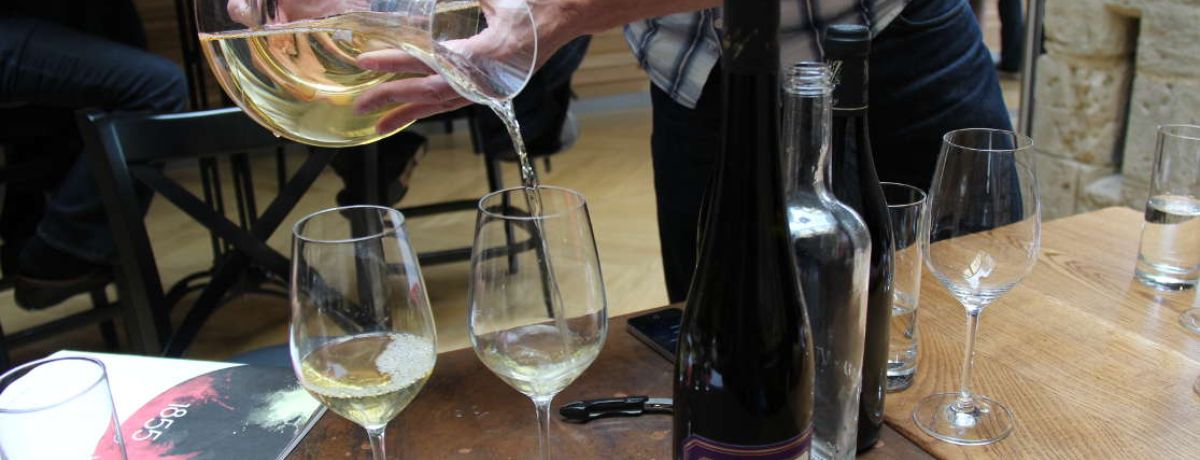Decanters and decanting

You can use any clean, watertight vessel to decant (pour the contents of) a bottle into. A china jug would do but glass is provably inert and has the great advantage of allowing you to enjoy looking at the colour of the wine (especially attractive for white wines). Proper, traditional decanters tend to be glass with a narrow neck so you can pour them easily and with a stopper so you can decide whether or not to keep air out.
Decanters tend to come in single- or double-bottle (magnum) sizes. Antique ones can be unearthed from junk shops for relatively little money, especially since you don't strictly need a stopper for a decanter used only for serving. See Where to find antique decanters for some specific suggestions.
Spirits and madeira can be kept in a (stoppered) decanter virtually forever but port and even sherry tends to deteriorate after a week or sometimes less. Wine that has not been strengthened by alcohol is often worse (and occasionally, in the case of concentrated, tannic monsters, better) after 24 hours in a decanter.
See the full story of the two decanters – one for young and one for mature wine - in the JancisRobinson.com Collection, pictured below, here.

To decant or not
There are strong practical reasons for separating a wine with sediment from that sediment, which can taste bitter and physically gets in the way of enjoyment. This traditionally involves standing the bottle upright for a day or two beforehand and pouring the wine into another clean glass container (glass is inert and if clear allows you to enjoy the colour of a wine, which can be a great pleasure) with a strong light source behind the bottleneck so that you can tell when the sediment is about to slip into the neck and can stop pouring at that point. That light source could be a candle or any strong light such as a desk light, table lamp without the shade or strip lighting under a wall-mounted cupboard. Bear in mind that some wines coat the inside of the bottle with a deposit that will not fall to the bottom of the bottle however long you stand it upright – but nor will it make the wine cloudy.
I often decant full bodied white wines which may have no sediment at all, simply because they look so gorgeously golden in a decanter. A glass jug or clean bottle would do just as well in practical terms. In the famous Locanda Cipriani on Torcello in the Venice lagoon, local fizzy white Prosecco is served in vast glass jugs.
Scientists say we should decant at the last possible moment so that no part of the wine's reaction with air be lost to us. As a host I confess I am prepared to sacrifice completeness for convenience with all but the most fragile old wines, say those over 25 years old, depending on their body and the style of the vintage. In practice therefore I tend to decant most wines that need decanting just before guests arrive, saving only really old bottles to be decanted just before serving.
Some young wines however are so tight and closed that, even though they are too young to have formed any sediment, they benefit from the aeration involved in pouring the wine from a closed bottle into another container. If I’m decanting for this reason, I’ll deliberately splash the wine as much as possible into a glass container with quite a wide neck. The same function can be performed by a gizmo such as Vinturi’s wine aerator mentioned in Wine gadgets and glasses; here there is no need for a decanter (other than for aesthetic reasons), as the wine can be poured straight from the bottle, through the aerator and into the glass.
I also find a stainless steel funnel with a fine mesh (or a clean funnel with coffee filter paper) useful for rescuing the wine from bottles into which corks have crumbled.
Here are some very rough practical guidelines for serious, reasonably expensive examples of the wine types cited below.
Decant immediately before serving:
Red bordeaux and Rhône reds more than 20 years old
Vintage port more than 50 years old
Decant 1-2 hours before serving:
Red bordeaux and Rhône reds five to 20 years old
Vintage port 10-50 years old
Decant splashily for maximum aeration up to four hours before serving:
Red bordeaux and Rhône reds less than five years old
Barolo, Barbaresco and Brunello
Modern Rioja, Ribera del Duero and Priorat
Bairrada, Dão and Douro reds
Vintage port less than 10 years old
Ambitious New World Cabernet and Syrah/Shiraz
Caring for glassware
Decanters are notoriously difficult to clean inside. Standing them full of a warm solution of denture cleanser can work. I’m also told that a product called Magic Balls, which cost very little and are available from good kitchenware shops, do the job well too – although I have no first hand experience. They come with a small sieve ready to pour the balls into, rinse through and dry on kitchen paper before putting back into their little pot. These also work for wine glasses that have turned milky in the dishwasher, apparently. Drying fragile glassware without leaving any residue can also prove challenging, and again there are products available to help with this if hand-drying each item with a microfibre cloth doesn’t appeal. A simple decanter dryer consists of a circular metal base with a central upright rod over which you ‘hang’ your decanter upside down to dry, and similar racks are available for wine glasses, allowing them to dry naturally without water marks (supposedly).